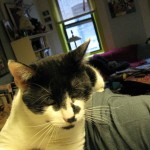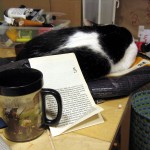1. Fundamental attribution error, assuming fallaciously that poor people are not as informed about bicycle transportation as rich people, especially rich people who ride bikes. It is not the case that poor people are unaware that bicycles exist or can be used to go from place to place more cheaply than the bus. It is also not the case that motorists stuck in traffic are unaware that bicycles exist. The flip side of this is the aggressive hunt for people who are absolutely unaware that bicycles exist, who are used as straw men to be set ablaze by the writer’s fiery rhetoric and incendiary logic. See ‘Poor People and Bicycling,’ ‘Despairing Season for Riding a Bicycle.’
2. Subjective worldview, assuming perhaps incorrectly that the advocate’s daily ride is representative of all locals’ daily rides, and therefore that fixing problems along the advocate’s route will make a big difference in ride quality across the city. The other way to conceive of this is to consider the impossibility of ranking poor bicycling conditions across a vast city like New York, especially since truly poor-quality bicycling repels bicyclists, including well-meaning bicycle advocates. See ‘Your Ride is Your Perspective,’ ‘Poor Infrastructure Is Everywhere.’
3. Masochism, or ‘Overcoming Obstacles for Fun.’ Sure, everyone wants to be more virtuous, but bicycling, like most activities, doesn’t make sense for people if it involves too much hassle, discomfort, and frustration. Getting on a bicycle in the wintertime is frustrating and uncomfortable. See ‘Despairing Season for Riding a Bicycle.’ It’s best to recognize this overtly and work on constructive ways to alleviate it, rather than celebrating the suck and hoping that other people are just as masochistic as the advocate. Conversely, masochists fail to celebrate actual joy in the performance of bicycling technique in favor of second-order benefits, like cardiovascular exercise and the ability to perceive the streetscape at pedestrian time-scales. This is tangentially related to Early Adopter Syndrome, in which people who get in on something at the start are consigned to using kludgy, inconvenient equipment to accomplish their goals, while people who start later on benefit from improvements in design. Just think of how much effort and specialized equipment were required in the early 2000s to get one’s bicycle to one’s Manhattan workplace and secure it there; now we have bike share and bikes in buildings!
4. Fighting for inadequate provisions, like these good people complaining that the bike lane on a relatively quiet street hasn’t been repainted, though the street has been marked with a double yellow center line, or this guy suggesting bike paths in highway medians. Oh, the noise! and smell! Let me give you a suggestion. If it would look weird to see a bicycle there, as in “Dad, look! There’s a guy on a bicycle! In the median!” perhaps that’s not the place for a bike lane. Nobody wants to look weird and out of place. Addressing the first issue, is there someone who decided not to bike on Seaman Avenue because the public-works department took away the bicycle lane? Maybe that marginal person on a bike just put the bike back on the balcony and took the bus instead.
5. Focusing on safety promotion instead of bicycle promotion. Assume there is a “safety deficit,” that people feel that bicycling is not safe enough for them to take part. Then, assume that vigorous attention has remedied this safety deficit and it’s not there any more. Bicycling is just as safe as people want it to be. Now, let’s ride! The same marketing campaign to get people into the saddle post-remedy could have been used pre-remedy. How are we in the future going to communicate the safety of bicycling in a way that is not true today? People will get in the bicycle saddle when it makes sense for them to get in the bicycle saddle. Spending time trying to make bicycling safer is a worthwhile way to spend time, but I don’t see how it gets more people into the saddle. See Safety Promotion vs. Bicycle Promotion.
6. Overreliance on imported models. Instead of doing the onerous anthropological work of figuring out who is actually riding a bicycle and how, work that is a natural but perhaps not obvious prerequisite to encouraging more people to ride bicycles, lazy advocates prefer to import models wholesale from the Netherlands and assign them to local populations. This overlaps somewhat with fundamental attribution bias, especially when zealous Omafiets riders attempt to explain how less doctrinaire bicyclists are doing it wrong by using the bike they had in the garage to commute. Americans are constantly being informed by these kinds of advocates that we are not riding correctly, that all we need is the right kind of neighborhood, the right kind of intersection, the right kind of bike lane, and the right kind of bike and we will be on our bicycles just like the Dutch. Well, yes: if Dutch bicycling is correct then we would do well to build new Hollands everywhere. But if bicycling is so fantastic, why does it have to be done with exactly one kind of bike, and one kind of street? I would prefer to support multiple variations of bicycling technique as I cannot authoritatively pronounce one way better than another.
7. Great expectations from aggregate data. The more people are counted, the more we are supposed to know. But what would we do any differently, knowing 10 times as many people as we thought were using the bike lane? It’s my considered opinion that bicycle infrastructure installation is not particularly dependent on descriptive statistics. The reserve army of bicyclists is not training on rollers, waiting for Mayor De Blasio to build it a bike lane.
8. Measurement bias. Rides that can be measured become the yardstick, and the data that can be conveniently gathered from open data repositories somehow becomes the entire story. I would like to know what the spread and success of local bike shops says for the technique, as local bike shops actually turn bicyclists per se into consumers and job creators, but that data is a lot harder to find. Easier to see how many people are using the local bike share kiosk. This goes along with subjective worldview, as the people who are doing the measuring are the ones providing the worldview.
9. Historical bias, e.g. “Bicycling: Now Safer Than Ever.” Bias toward the past, and what happened in the past, and away from the future, and what we plan to happen. We overvalue the incidents that happened in the past, and neglect to take into account recent interventions to address those incidents, and undervalue what will happen in the future. It took me a while to see this one as its own fallacy. It can be viewed, however, in the inability of safety interventions to change people’s attitudes about the safety of bicycling. Folks will always remember how unsafe it felt the last time they got on a bicycle… in 1999.



